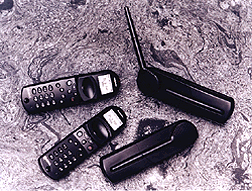
SSS Online NEWS
Number 1 -- Updated May 11, 1998

Whats New at SSS and in the World of SS, RF and Wireless
[SSS Online's New Look]
[Introducing "HomeRF"]
[Of PDAs and Men]
SSS is proud to bring you our Very First SSS NEWS Page!


SSS Onlines's New Look -- What's New at SSS
We now have received 18 Awards -- CLICK HERE to View All Our Awards
SSS Online Gets New Face, Features and Feel!
SSS has recently put on a brand new face. We have added new features,
new content and a new look to SSS Online. All this was done to improve our
image, simplify site navigation and attract more visitors.
We've also won a couple of WEB Site awards for all this hard work. We
are proud to have been selected for these awards and we certainly thank the
organizations that thought we were worthy of them. We hope to continually
improve this site and make it not only easier to use, but more valuable to the
visitor as well.
We have made visible changes to simplify navigation around our site,
help our pages load faster and make this site less confusing for newcomers.
We have added several major new features and navigation tools to make
everyone's life easier in using SSS Online. The most notable new feature
along this line is our left hand "yellow" navigation bar. This bar will appear on
most of our pages as an aid to jumping around our site and to provide a uniform
navigation interface.
Some of our other new features include SS Forums, SSS Online Chat Room,
several new map, index and keyword search site navigation tools and a new
"Frames Look" that simplifies finding things on our site. Further, we've added
Go to EDTN! link and a EDTN LINKS inset Nav Box in the left hand Navigation
Bar to help users take advantage of our sponsor / partner EDTN's WEB features.
Spread Spectrum Scene Online magazine has been online on the
Internet now for two and a half years! As you can see, we have been
updating, refining and adding new content and new features since the first of
this year. We now have several paying commercial advertisers for our home
page rotating banner ads. We also have completed a "partnership deal" with
EDTN whereby we will be running ads for them and their advertising
sponsors and we will receive income and substantial other benefits from the
CMP Publishing Group and EDTN, LLC. These two new events have given
SSS Online new sources of income and have demonstrably shown our prestige
and presence on the WEB.
Please drop us an email (randyrf@sss-mag.com) or leave a Comment if you would like to share your
thoughts, suggestions or ideas with us on how to improve SSS Online and thus
serve you better!


Introducing "HomeRF" -- An Idea Whose time Has Come?
THE LATEST INDUSTRY NEWS IS: HEAVYWEIGHTS FORM GROUP FOR WIRELESS HOME NETWORK
On March 5, 1998, a group of companies from the computer, telecommunications
and consumer electronics worlds joined forces to develop a specification for
wireless communications in the home. The collective or consortium, which
calls itself the Home Radio Frequency Working Group (HRFWG), is developing
its Shared Wireless Access Protocol (aka SWAP), which it expects to publish later
this year. Members of the group include Compaq, Ericsson,
Hewlett-Packard, IBM, Intel, Microsoft, Motorola and Philips and others.
The HRFWG says its goal is to provide an "open" specification that will provide the foundation
for a broad range of interoperable consumer devices, such as handsets, remote
display pads and computer peripherals, which will communicate wirelessly with the
home PC. The SWAP will utilize the ISM radio band of 2,400 to 2,483.5 MHz to
transmit voice and data at rates upwards of 1Mb per second. The group says it
will be signing up more members soon and that the first products based on SWAP
should be appearing in late 1999.
Shared Wireless Access Protocol
SWAP, the Shared Wireless Access Protocol, defines a new common interface
specification supporting wireless voice and data services in the home. Because
of the numerous and diverse nature of companies and products within the PC,
telecom and consumer electronics industries, the SWAP specification is critical
to ensure that the myriad of products are interoperable. Examples of what
users will be able to do with the availability of products that adhere to the SWAP
specification include:
- Set up a wireless home network to share voice and data between peripherals,
PCs and new devices such as portable, remote display pads
- Review incoming voice, FAX and e-mail messages from a small cordless telephone handset
- Intelligently forward incoming telephone calls to multiple cordless handsets, FAX machines
and voice mailboxes
- Access the Internet from anywhere in and around the home from portable display devices
- Activate other home electronic systems by simply speaking a command into a cordless handset
The HRFWG plans to publish the SWAP specification by fall of 1998 and companies may begin
product development shortly thereafter. The group expects the first SWAP-compatible commercial
products to be introduced in the second half of 1999. For more information on the HRFWG and
SWAP specification direct your browser to http://www.homerf.com.
SSS Online Comments and Thoughts / Suggestions
Well the "Big Guys" have done it again! Turn a few "gorillas" loose in small room and they will either
annihilate each other or else they form a committee to study why and how they got into this little room
in the first place. It seems these "Heavyweights" have just done the latter!
Do these guys have any idea what they are doing? I don't think so -- take their choice of frequency
band, it is definitely a big mistake to choose the 2.4 GHz ISM band for the HomeRF hardware! Any forward
thinking RF engineer will tell you the next BIG commercial Unlicensed frequency band is going to be in the
5.2 to 5.8 GHz range. Technology, chips and government regulations are moving fast to make this higher
frequency territory the band of choice for short range, low power, battery operated equipment!
Further, the 2.4 GHz band is becoming increasingly crowded and subject to interference, just like
the 915 MHz band did a few years ago. We have developed simple, inexpensive low power transmitters
and receivers (and transceivers) for the 5 GHz frequency range that utilize the latest in GaAs and
CMOS technologies and can operate in either SS or digital modulations modes at speeds up to 20 Mbps.
I guess the HRFWG guys (and girls) are really ostriches, with their heads in the sand, because they
have absolutely no idea about what's going on in the RF technology area!
Remember the IEEE 802.11 spec fiasco? It took at least Four Years for the standard to be worked
out and agreed to by another Industry Group -- I'll bet you a donut, that's what will happen here, too!
I really think the idea of a suite of products, based on an Industry standard Interface is a
great idea! I also think that short range, low cost hardware can be developed to support numerous
applications for the Home and Small Business market niches. Finally, I think the overall HomeRF
concept is a great one -- just, please get real and learn something about RF before you write your spec!
So, you HRFWG folks -- if you want any useful help, ideas or suggestions, why not give us a call,
email, or FAX -- we'd be glad to help you out with solid, logical, knowledgable ideas and suggestions!


Of PDAs and Men -- Are the Newest PDAs an Improvement or a Dead End?
Remember "Of Mice and Men?"
As the ad below announces, there are new PDAs (or Windows CE2 devices, or whatever you
want to call them) available now! Are these new PDAs any good? Are they better than
Apple's "Newton" was? Are they more useful than my under $100 Casio pocket organizer?
This short article will attempt to answer these questions, admittedly from our somewhat
biased viewpoint, but we will try to discuss these neat new little gadgets from the standpoint
of their Wireless connectivity and usefulness.

There is a whole new crop of 3Com PalmPilot look alikes coming out soon, along
with a next generation of other CE and portable or handheld PCs. Some of these
devices are pretty good and pretty useful. Almost all of them fail miserably in
the area of truly useful Wireless connectivity. But, some of the newest units can
actually reach a few meters with up to 4 Mbps Diffuse IR connectivity technology!
Last summer I got the PDA bug again and went out and bought one of the neat little HP320LX units.
It had lots of memory, good battery life, lots of software and accessory support -- but, I
could barely see the display, let alone "type" on its keyboard! Now HP has a little
more expensive unit with a much better Color display. Maybe I'll go out and buy one these too
and give the old one to my dog to chew on, or something.
Seriously, these little HP units are pretty darn good at a lot of things. They have a
PCMCIA slot, a Flash memory slot and even a serial I/O port (when plugged into the unit's
docking cradle). But, are these units any good at Wireless connectivity? Definitely NOT,
at any distance beyond the few feet that their built-in IR capability provides!
That's really my hands-on experience so far with this recent crop of PDAs. I have
seen the ads and new product promos on all the latest other neat units, but I can't
truly say that I've used any of them yet! I have reached a conclusion, however, about
PDAs in general when I think I want a PDA that REALLY has useful Wireless connectivity.

Very simply -- wait till next year! Globalstar and possibly other LEO satellite
systems will be operational next year and they can provide THE SOLUTION for Wireless
connectivity for PDAs or Wireless Internet access or voice + data or worlwide FAX
capability, or what have you.

All of the really smart vendors of PDAs, laptops, notebooks, sub-notebooks, PCMCIA modems,
etc. will have products out next year to work with these worldwide coverage LEO satellite
networks / systems. Just like the wisdom of purchasing a big new TV set today, when you
know that next year or so the latest Digital TV sets will be out. I think most people will
wait on the new TV set purchase and most of us techies will probably also wait to buy a new PDA!
My recommendation is thus pretty clear:
Go down to your favorite PDA store (or look around the WEB) and touch, feel,
evaluate, compare, try and then just think about the 1 meter long TETHER that all
of todays PDAs have. Don't you think you should wait till next year to buy one?
Todays PDAs are indeed a dead end, in our opinion!

In October 2000, this website was purchased by
SSS Online, Inc. and is managed by Pegasus Technologies. For more of the best information
on RF/Spread Spectrum and wireless, press one of the buttons below:

|
|
|